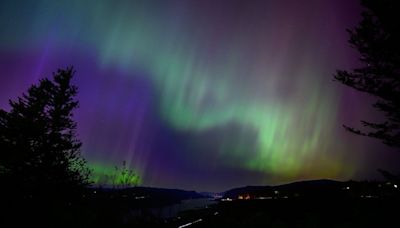Search results
1 day ago · A storm is brewing. A solar storm, that is. It’s already been a banner year for northern lights viewing in Canada this year, but Mother Nature isn’t done yet. A strong solar storm is expected ...
1 day ago · An onlooker gazes up at the spectacular northern lights display on May 10, 80 kilometres from Airdrie, Alta. Recent solar activity means there is a chance for more northern lights this week ...
What are the northern lights? Information about auroras and the role of the Sun in their formation. The colours of the northern lights. Factors that determine the different colours of the aurora. AuroraMAX observatory. Online observatory to watch Canada's northern lights in high definition. Aurora viewing tips
An aurora (pl. aurorae or auroras), also commonly known as the northern lights (aurora borealis) or southern lights (aurora australis), is a natural light display in Earth's sky, predominantly seen in high-latitude regions (around the Arctic and Antarctic). Auroras display dynamic patterns of brilliant lights that appear as curtains, rays ...
This is a short-term forecast of the location and intensity of the aurora. This product is based on the OVATION model and provides a 30 to 90 minute forecast of the location and intensity of the aurora. The forecast lead time is the time it takes for the solar wind to travel from the L1 observation point to Earth.
The two maps show the aurora and viewline tonight and tomorrow night. The brightness and location of the aurora is typically shown as a green oval centered on Earth’s magnetic pole. The green ovals turn red when the aurora is forecasted to be more intense.
Jul 23, 2024 · The northern lights are created when energized particles from the sun slam into Earth's upper atmosphere at speeds of up to 45 million mph (72 million kph), but our planet's magnetic field...
Oct 19, 2023 · The northern lights (aurora borealis) put on a display above the snowy landscape of Vee Lake, Northwest Territories, Canada. Auroras, also called the "polar lights," are rarely visible outside 70 degrees north and south latitudes. Photograph by Dave Brosha, MyShot. Article. Vocabulary. An aurora is a natural light display that shimmers in the sky.
1 day ago · Northern lights could be visible over mid-latitudes across the US and Europe on July 30. A geomagnetic storm watch has been issued by NOAA's Space Weather Prediction Center.
3 days ago · The aurora is a luminous glow seen around the magnetic poles of the northern and southern hemispheres. The light is caused by collisions between electrically charged particles streaming out from the sun in the solar wind that enter Earth’s atmosphere and collide with molecules and atoms of gas, primarily oxygen and nitrogen.

